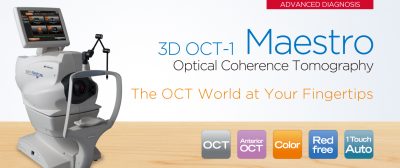SW & C Jackson Opticians are proud to announce that we have just ordered a Topcon Maestro Optical Coherence Tomographer (OCT). It will be a few weeks till it arrives in the practice as all the staff need to recieve training but in the mean time here is a bit of information about the benefits of OCT
Optical coherence tomography (OCT) is an imaging technique that uses coherent light to capture micrometer-resolution, two- and three-dimensional images from within optical scattering media (e.g., biological tissueOCT – Ocular Coherence Tomography – is an advanced eye scan for people of all ages. Similar to ultrasound, OCT uses light rather than sound waves to illustrate the different layers that make up the back of your eye. The OCT machine captures both a fundus photograph and a cross-sectional scan of the back of the eye at the same time).
What can the scan check for?
Common conditions identified through regular OCT screening include:
1. Age-related macular degeneration
Macular degeneration causes the gradual breakdown of the macular (the central portion of the eye). OCT can identify this condition and its type (there are two types, wet and dry) and also monitor its progress, for example if you are undergoing treatment for such a condition. Unfortunately the risk of developing macular degeneration increases with age, and it is the most common cause of vision loss in individuals over the age of fifty.
2. Diabetes
Diabetic retinopathy is a major cause of visual impairment among adults. Here in the UK, more than
two million people have been identified as having diabetes. OCT examination enables early detection, which greatly improves the success rate of treatment.
3. Glaucoma
Glaucoma damages the optic nerve at the point where it leaves the eye. Recent statistics suggest that some form of glaucoma affects around two in every 100 people over the age of 40. The danger with chronic glaucoma is that there is no pain and your eyesight will seem to be unchanged, but your vision is being damaged. An OCT examination will confirm if you are at risk, or indeed what stage of glaucoma you may have.
4. Macular holes
A macular hole is a small hole in the macular – the part of the retina which is responsible for our sharp, detailed, central vision. This is the vision we use when we are looking directly at things, when reading, sewing or using a computer. There are many causes of macular holes. One is caused by vitreous detachment, when the vitreous pulls away from the back of the eye and sometimes it does not ‘let go’ and eventually tears the retina, leaving a hole. Extreme exposure to sunlight (for example staring at the sun during an eclipse) can also cause a macular hole to develop.
5. Vitreous detachments
Vitreomacular traction can clearly be diagnosed through OCT providing invaluable information about the current relationship between the vitreous and the retinal surface of the eye. As people get older the vitreous jelly that takes up the space in our eyeball can change. It becomes less firm and can move away from the back of the eye towards the centre, in some cases parts do not detach and cause ‘pulling’ of the retinal surface. The danger of a vitreous detachment is that there is no pain and your eyesight will seem unchanged but the back of your eye may be being damaged.

